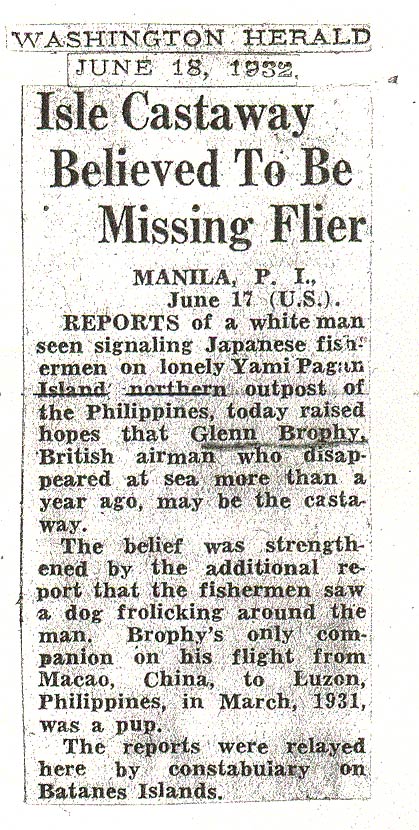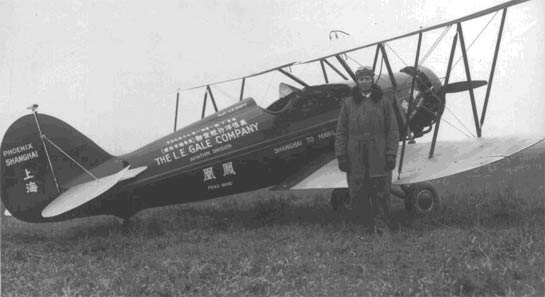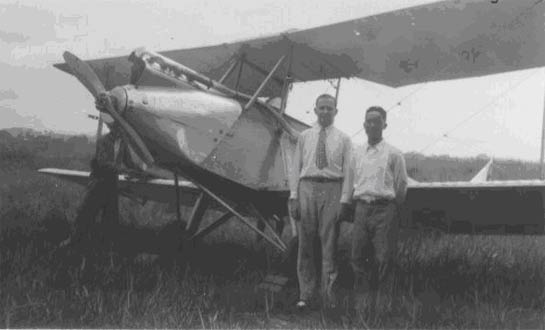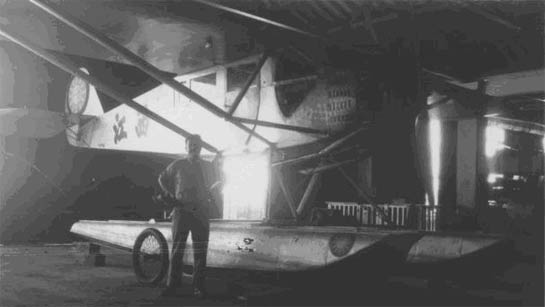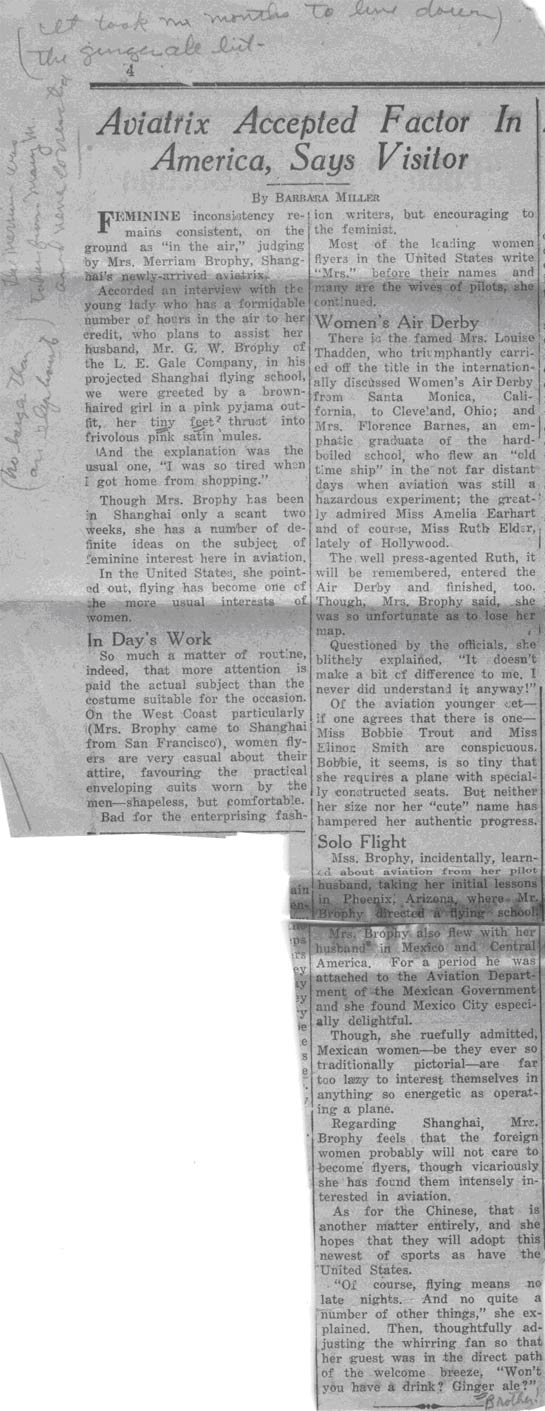|
CASTAWAY?
Los Angeles Times, March 3, 1929
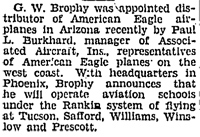 |
Glenn Warren Brophy was the principal of Arizona Flying
Service, Van Buren Airport, Phoenix, AZ. He landed at Tucson
five times in three different aircraft between May 7, and
September 2, 1929. He carried passengers on four of his visits,
and their itineraries generally focused on cities of the
southwest, ranging from Los Angeles to Huechia, Mexico. The small article, right, from the Los Angeles Times, tells us why. The Rankin system was developed by Register pilot Tex Rankin.
He came to Tucson flying an American Eagle Phaeton 7103,
a Standard J-1 NC2472,
one of the oldest aircraft to land at the Airfield, and a
Monocoupe NC7311.
See the respective links for information about those aircraft,
and the context around Brophy's visits to Tucson with them.
Brophy's landings at
the Airfield preceded a harrowing adventure, of which, at
this writing, I am not sure about the outcome. Barely a year
after his last Tucson landing, he was working as manager
of the aviation division of the L.E. Gale Company of Shanghai.
He and his wife moved to China.
The Gale Company was an importer of aircraft from the U.S.
to China. To build business, Brophy was tasked with the job
of blazing an airplane trail for mail and passenger service
from Shanghai to Manila via Foochow, Canton and Macao.
A Bumpy Start
Brophy left Shanghai on January 17, 1931 on his pathfinding
venture. A few days later, the Newark (NJ) Star Eagle of January 23, 1931
headlined, "U.S. FLYER FORCED TO LAND IN CHINA".
Fog was the reason given for the landing. He was uninjured.
On his second takeoff, on January 27, he was again forced
down in China, thirty miles southeast of Foochow. Ice formed
on the wings, and the propeller was slightly damaged. He
was, again, uninjured. Refer to the images below to see what
he and his airplane looked like in January 1931.
A Hiatus, Another Attempt,
and a Disappearance
Almost two months later, on Thursday March 19, 1931, the
Newark (NJ) Evening News reported that Brophy had left Macao
at 8:50AM that morning and was overdue at Manila, a 600 mile
flight over water. The New York Sun reported no
sign of him on March 21, 1931.
The search was formidable. Seven destroyers, two destroyer
tenders, two aircraft carriers and their complement of aircraft
were deployed. L.E. Gale told The New York Times on Saturday
March 21, 1931 that the fuselage of the airplane had been stuffed
with, "...strongly inflated air-tight bags. Several
life rafts and life belts also were in the equipment...and
these together with wings should keep the plane afloat several
days." Gale was convinced Brophy was drifting somewhere
in the South China Sea and would be found if the Navy continued
its intensive search.
That was not to be. The New York Times of March 22, 1931 reported
that, after 47 hours of searching over 34,000 square miles
on all possible courses and drift patterns the plane might
have taken, the search would be discontinued after the 22nd.
On March 23, 1931 The New York Times reported a cessation of search
activities and the return of the search fleet.
A Year Later...
The Washington Herald reports:
Frustratingly, that's where my information ends. Anybody
KNOW anything
about pilot Brophy's fate? Stand by for further developments.
---o0o---
And here is a further development as of August 3, 2006.
I received these images and comments from a grand niece of
pilot Brophy (see credit in right sidebar).
Above is Brophy standing by one of the Gale Company aircraft, a Waco RNF (see below).
This is probably the aircraft in which he was lost on
his way to Manila. His niece says of the image:
| "This is the bi-plane used in the mail
route from Shanghai to Manila in 1931. This was probably
one of the last photos ever taken of Warren Brophy as the
date on the back of the photo is January, 1931. It
isn’t easy to read in this scanned image but on the
top of the plane, near the cockpit, is painted “Pilot-G.W.
Brophy”. Note the words on the tail – “Phoenix,
Shanghai” and the words on the side of the plane,
nearest Warren, “Shanghai to Manila” The
words directly below the Chinese characters read,”Feng
Wang”. Not sure what that means...." |
A site visitor from Nanking shares the following translation of the Chinese characters, "The two Chinese characters on the plane [below the fuselage stripe] mean 'Phoenix' and their pronunciation is 'Feng Wang.' The traditional way of Chinese writing is from right to left. So the right character is ,'Feng' [and] the left one is 'Wang'." And further, "The Chinese words above 'The L.E.Gale Company' mean 'Aviation Division of L.E.Gale Company.'" The top line means "Waco F series- Warner one hundred and twenty five hp engine." The two ideograms on the rudder below SHANGHAI are just that, "Shang," the top character, and "Hai."
The image below shows Brophy in Canton, China sometime in
1930. Note on back of photo reads, “Chinese-made plane
copied from an American plane.” The man
in the necktie is Glenn Warren Brophy.
Below is a Ryan aircraft exported to China. Caption on back
of photo reads, "Canton, China, 1930 - Ryan planes delivered
with one of the pilots”.
Below is a news interview of Mary Brophy, probably soon
after she and her husband reached China. Their niece says
the following about the article:
"This is an undated article from an unknown
newspaper published in Shanghai. It is an interview
with Mary (Whelan) Brophy, Glenn Warren Brophy’s
wife. The
article mistakenly refers to her as “Merriam”. Her
handwritten notes in the margin explains, 'The “Merriam” was
taken from "Mary M." and never corrected.'
(Her middle name was Magdelena) The article makes
reference to Amelia Earhart, Ruth Elder, Bobbi
Trout and Pancho
Barnes.
"The last comment about Mary offering the reporter
ginger ale was also commented on in the margins, “It
took me months to live down the ginger ale bit”. |
The tone of the article, as for many articles written about
female aviators of the era, is sexist, even though it was
authored by a female reporter.
Alas, even with these excellent sources, we still do not
know the fate of Glenn Warren Brophy. His niece concludes,
"There was always some speculation that Warren may have
been spying on the Japanese for the Chinese and/or American
government due to some irregularities of his last flight.
As far as what eventually happened to him, no one really
knows. The report of the blonde man on the island seems to
be the last possible trace of him."
---o0o---
November 2006 Update:
An email exchange with Lennart Andersson, an
aviation historian from Sweden with an interest in China
aviation, provides us with the following information (edited
from his emails to me):
A trio of Waco aircraft of different
models, all three-seat biplanes, were sent out to L.E.
Gale in China in 1930 for demonstrations: a CSO (225
hp Wright J-6 Whirlwind), c/n 3115, an MNF (125
hp Menasco Pirate C-4), c/n 3408 (ex US Reg 11213),
and an RNF (110 hp Warner Scarab),
c/n 3359. The airplane appearing first on this page
(see above) is the Waco RNF. The
Chinese characters mean "Shanghai" (rudder) and "Phoenix" (fuselage).
The trio of Wacos probably arrived late in 1930, as
one was demonstrated by Brophy in December or early
in 1931. The MNF was demonstrated by an American pilot
named Williams at Mukden in the spring, but was not
flown after May due to engine problems. It was seized
by the Japanese.
On 23 January 1931 Brophy left Shanghai in the RNF,
now named “Feng Wang” (Phoenix), which
had been fitted with an extra fuel tank in the front
cockpit for an attempt to fly to the Philippines. He
got lost, however, and instead arrived in Canton
about 18 February. As the news articles
imply, he
made several attempts before finally taking
off from Macao on 19 March, only to disappear without
trace.
The second airplane pictured above is probably an
Avro 594 Avian IV (Cirrus engine) and not a "Chinese
built" copy. If it was photographed in 1930 Mr. Andersson
suspects that it
is a British-built example. It could also be one of
three Avro 616
Avian IVMs that were
delivered at the end of July 1930 and were fitted with
Cirrus engines locally. Perhaps that is why they were
called "Chinese built". Copies of Avians were built
at Canton, but only in 1933.
The third photo above Mr. Andersson believes is
a B-1, but could also be a B-5. It is named "Hsichiang/Hsikiang/Hsi
Chiang". He has no idea who the person is, but the
photo is taken at Canton.
|
Further, Mr. Andersson sends us this article, right, from The New York Times, March 21, 1931.
He also cites for us a book by E.B. Santos titled "Trails
in Philippine Skies". Here is what that book says about Brophy's
trial. Note the interesting details of what the pilot carried,
and of the rescue operation mounted to find him.
"On March 19, Glenn Warren Brophy, an American, left
the race track in Macao in a single-seat Stearman [sic, it
was actually the Waco RNF pictured above] biplane and headed
southwestward on an attempt to make the first solo Shanghai-Manila
flight. The L.E. Gale Company in Shanghai was his sponsor.
"Brophy named his plane the Phoenix. He had been waiting
at Macao for good weather over the South China Sea for more
than a week. Thrice he took off and thrice he was turned
back by strong winds and thick clouds over the Pratas Reef.
The skies finally cleared somewhat on Thrusday, March 19.
He decided to leave again.
"A small crowd came to see Brophy off. The mayor of Macao
handed him a letter to deliver to the mayor of Manila. The
pilot also was carring 500 pieces of mail from Macao and
400 other pieces from Shanghai, Foochow, Swatow and Hongkong.
"With Brophy in the plane was a black chow puppy given him
by the 'Macao Review'. he named it 'Contact'. For sustenance
during the flight, the pilot had a few chocolate bars, some
fruits, a bottle of water and pack of cigarets [sic]. As emergency
equipment, he had lifevests and liferafts and 'air bags'
stuffed inside the plane to keep it afloat in case he had
to land at sea.
"The Phoenix was loaded with 125 gallons of gasoline,
considered enough for 10 hours, and Brophy had hoped to reach
Manila in less than five. He intended to circle over the
Pratas Reef and drop a package with magazines and a letter
of thanks to the weather station there for its reports to
him. Then he would head for Poro Point in San Fernando, La
Union, and proceed to Nichols Field from there.
"'Not so good, but I'm going to chance it,' Brophy
told his assistant, Ed Curtiss, as they looked up at a murkey
sky in Macao on March 19. If he were forced down, he said,
he would send up a red flare every hour on the hour. He carried
20 flares, each of which could burn for 20 minutes. He estimated
his arrival in Manila at two P.M.
"In his cockpit with the engine turning over, Brophy
shook hands with his sponsor and taxied out. In Manila, Mrs.
Brophy had been waiting since March 10 when she arrived by
boat. Interviewed in her Manila Hotel room, Mrs. Brophy said
she was sure her husband would succeed. She would keep to
the hotel until he arrived and then they would be busy 'stepping
out'. She had brought with her Brophy's tuxedo and evening
pumps.
"The weather was not as good as Brophy had hoped. From
Pratas Reef, the observers reported a strong northeast wind
and poor visibility. A steamer reported to Macao that it
sighted the Phoenix at 9:10 P.M. 15 miles out of the City.
That was the last time anyone saw the plane. The men on Pratas
maintained a lookout for Brophy. But he failed to appear.
As the day lengthened and no word of Brophy's whereabouts
had been received from Manila and ships at sea, Macao and
Shanghai became uneasy.
"By nightfall, the cities on both ends of Brophy's
intended route prepared a search for him. Gale, backer of
the flight, cabled the U.S. Navy commander in Manila from
Shanghai to ask for assistance. He also told the press the
plane could be expected to remain afloat 'for many days'
because of its emergency equipment.
"Three U.S. Navy destroyers and the seaplane tender 'Heron' steamed
out of Manila Bay at 11 p.m., March 19, to scour the western
coastline of Luzon and the adjacent waters of the South China
Sea. Four more destroyers were told to stand by. Hines ordered
the Sikorskys to leave at daylight, with fuel for 6.5 hours,
one to search along the coast and the other to fly 10 miles
out over the sea in a parallel course up to the Batanes.
The planes would refuel at Aparri before returning to Manila.
Friends of Mrs. Brophy took her from the hotel into their
home at Nichols Field.
"In Macao early the following day, Air Force Commander
Cabral set out in a seaplane and attempted to trace Brophy's
route up to the Pratas Reef. He was in the air for five hours,
but he could reach only the small islands between Macao and
the reef. Rain and clouds prevented him from getting to the
reef and he returned to Macao, landing there at three p.m.
In Shanghai, Gale remained confident that Brophy was still
afloat somewhere and would be found.
"But the sea and air searches on March 19 proved fruitless.
The U.S. Navy threw in the four other destroyers, another
seaplane tender and more planes into the effort. The destroyers
lifted anchor at six in the evening of May 20, to make a
wide sweep of the China Sea in a line abreast off Corregidor
to San Fernando. The seaplane tender left Olongapo at 2:35
P.M. May 20, to take up station off Cape Bolinao. At daylight,
six planes departed from Olongapo to search as far out as
90 miles out of San Fernando. The army Sikorskys spent the
night of March 19 at Aparri and resumed their search the
next day, with special attention to the small islands in
the Batanes Group.
"A report from Lingayen at eight P.M. March 20 that a plane
had been sighted on its way to Manila sent reporters, photographers
and aviation enthusiasts rushing to Nichols. They thought
that it might be Brophy's plane despite the fact that he
was more than 24 hours overdue. The plane turned out to be
one of the navy's.
"Hopes for Brophy's survival finally collapsed on the
evening of March 21. Mrs. Brophy went into seclusion. The
planes and ships returned to their bases the following day.
It had cost the U.S. Navy some $75,000 to undertake the search.
An Associated Press story on March 24 indicated that despite
the foul weather, Brophy had decided on taking off from Macao
after receiving a telegram from a 'cheap fellow' in Manila
who offered to make the flight in Brophy's place for $1,000
in gold if the pilot thought he could not make it. The AP
representative in Macao said Brophy told him of the wire
just before the latter left. 'He was rather upset,' said the
correspondent.
"Brophy's name faded from the headlines...."
---o0o---
Further, another update, November 2006. These two articles
from The New York Times of March 20, 1931 and March 22, 1931 provide
addtional insight into the searches. Files courtesy of Matthew
Miller, site visitor.
---o0o---
Dossier 2.1.58
UPLOADED: 03/12/06 REVISED: 08/03/06, 11/10/06, 11/11/06,
11/20/06, 07/18/09
|



